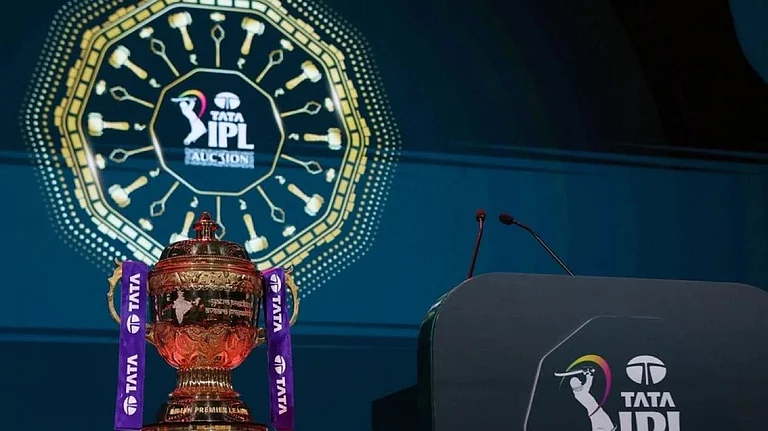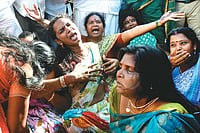Within two months of the passing away of the then Tamil Nadu chief minister J. Jayalalitha, V.K. Sasikala, who entered Jayalalitha’s household as her caretaker and aide in the late 1980s, has staked claim to become the third woman CM of the state. This has triggered outrage among various sections of the people.
Wielding enormous money power, Sasikala carved out an influential role for herself in the All India Anna Dravida Munnetra Kazhagam (AIADMK), by getting elected as the general secretary, a post held earlier by party founder M.G. Ramachandran (MGR) and then Jayalalitha. From there to forcing out O. Panneerselvam, who took over as CM after Jayalalitha’s death last December, was but a short step.
In ousting Panneerselvam, who apparently had the blessings of the central government, Sasikala has taken a calculated risk. After all, the AIADMK has 37 MPs in the Lok Sabha and, as per the latest headcount, 128 out of 234 MLAs in the Tamil Nadu assembly are with her. The Modi government, through Governor C. Vidyasagar Rao, has allegedly sought to delay her elevation, in the hope that the Supreme Court verdict in the disproportionate assets case, expected to be pronounced one of these days, will go against her, barring her from running for public office for six years.
Sources say the governor may meet AIADMK legislators individually to find out whether they have thrown in their lot with Sasikala of their own free will, or were coerced into it as Panneerselvam has alleged he was. But since the governor has accepted Panneerselvam’s resignation, there is no way he can allow him to withdraw it.
So, in a nutshell, this is the current situation in Tamil Nadu: a caretaker chief minister, a cabinet of ministers that does not care for him, a CM-in-waiting and governance in limbo. Sasikala’s attempted coup has caused widespread resentment not only among the educated middle class, but also among the poor, especially women. That is because she is seen as a behind-the-screen operator trying to usurp power.
In sharp contrast, there was no such moral indignation when Janaki Ramachandran succeeded MGR as chief minister in 1988, following his demise, or even when the heroine in many of his films, Jayalalitha, took charge as CM in 1991. Now that Sasikala, whom Jayalalitha euphemistically called her personal aide or housekeeper, has manoeuvred herself into the top post, the twitterati cries this is the limit.

Jayalalitha at M.G. Ramachandran’s funeral in 1987
Janaki was a political novice who was thrown into the cesspool of politics and made chief minister by R.M. Veerappan, a producer of MGR’s films, to checkmate an ambitious Jayalalitha. Despite earning mention as the first woman CM of Tamil Nadu, Janaki faded out of politics after her government was dismissed within days of assuming office, following a farcical vote of confidence.
Jayalalitha had to struggle for the CM’s post and her ambition was realised only in 1991, even though MGR used to lean on her to guide him through the files he had to deal with after coming to power in 1977 and had made her the AIADMK’s propaganda secretary in 1983 to legitimise her status. On the other hand, Sasikala’s only claim to power is that she ran Jayalalitha’s household for over 30 years and stood by her through thick and thin, in sickness and in health, except on two occasions. She was expelled from the party and Jayalalitha’s residence twice—the first time in 1996 when AIADMK was routed because of public anger against widespread corruption and vulgar display of wealth as seen at the wedding of her nephew and Jayalalitha’s “adopted son”, Sudhakaran. Sasikala was expelled once again in December 2011 when Jayalalitha suspected her of plotting to capture power in the event of her conviction in the disproportionate assets case.
Jayalalitha gave Sasikala no post in the party and much less in the government. As a result, she has had no experience in organisational politics or administration. Moreover, both times that Jayalalitha was forced out of the CM’s chair—first in 2001 and again in September 2015, when a special court in Bengaluru held her guilty of corrupt practices, leading to her instant disqualification—she chose Panneerselvam as her successor. This history has given enough grist to the public anger against Sasikala.
Coming from a middle-class household in Mannargudi, Thanjavur district, Sasikala used to run a video rental shop in the early 1980s. In 1983, when Jayalalitha addressed her first public meeting as AIADMK propaganda secretary in Cuddalore, the then district collector V. Chandralekha introduced Sasikala to her. But so long as MGR was alive, she kept her distance from Jayalalitha. It was only after MGR’s death in December 1987 that Sasikala gradually moved into Jayalalitha’s Poes Garden residence, where she continues to stay.
Soon the entire clan, barring her husband M. Natarajan, moved into Poes Garden and took advantage of their proximity with Jayalalitha when she became chief minister in 1991. Not only Sasikala, but her sister-in-law Ilavarasi, nephews Sudhakaran, Vivekanandan and Dinakaran (who controls Jaya TV), among others, have turned multi-millionaires over the years. Critics call them the Mannargudi mafia, which has spread its tentacles and controls many businesses, including the liquor trade.
“As Jayalalitha got older and was afflicted by a host of conditions such as high blood pressure and uncontrolled diabetes, she started delegating more and more tasks related to running the government or the party to Sasikala,” says S. Thirunavukkarasar, Tamil Nadu state chief of the Congress, who was once close to Jayalalitha in the late 1980s before her ascension to the CM’s chair. With Jayalalitha under a vice-like grip, Sasikala slowly and systematically sidelined old MGR loyalists such as Thirunavukkarasar, Veerappan and S. Muthusamy, and packed the party with her own handpicked loyalists. Though Jayalalitha was aware of Sasikala’s growing clout, she did not take serious note of how Sasikala posed a threat to her own position, except the two times she threw her out of the party and her house.
Sasikala went to jail with Jayalalitha when both were convicted in a slew of corruption cases between 1996 and 2014. The Dravida Munnetra Kazhagam (DMK), which initiated the cases after coming to power in 1996, tried to make Sasikala an approver as its main target was Jayalalitha. Sasikala refused.
The last of the cases, the disproportionate assets case, ended with a special court in Bangalore convicting both of them. In March 2015, the Karnataka High Court acquitted Jayalalitha. The Supreme Court’s verdict on Karnataka’s appeal against the acquittal is expected any time in the days to come.
In December 2011, when Jayalalitha suspected that Natarajan was plotting to capture the party in case she gets convicted, Sasikala claimed she was unaware of the plot and reaffirmed her loyalty to her by declaring she had no personal ambition. It is this tainted legacy that is at the root of the public dislike of Sasikala. In any case, her political future depends on the apex court’s verdict in the disproportionate assets case.























